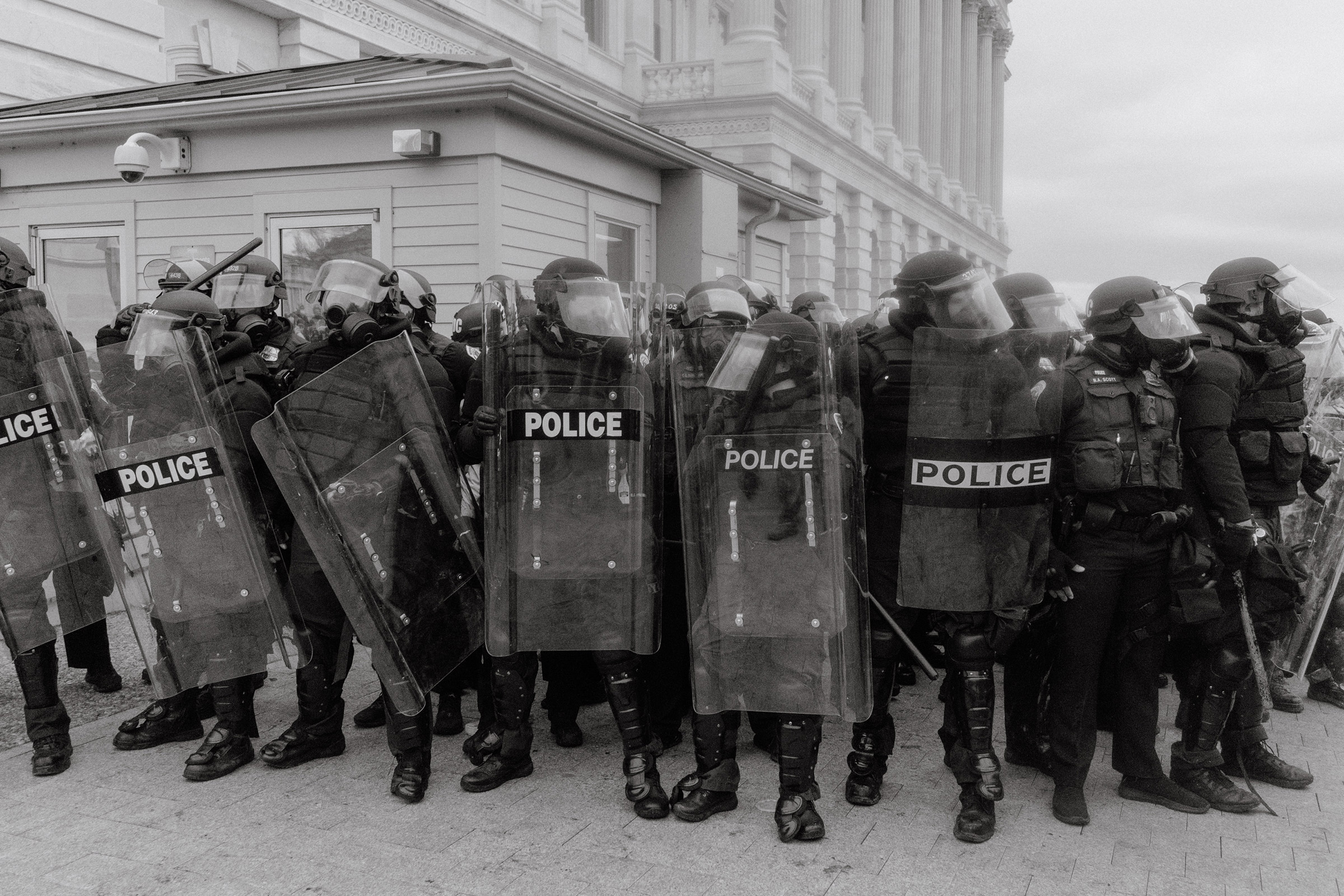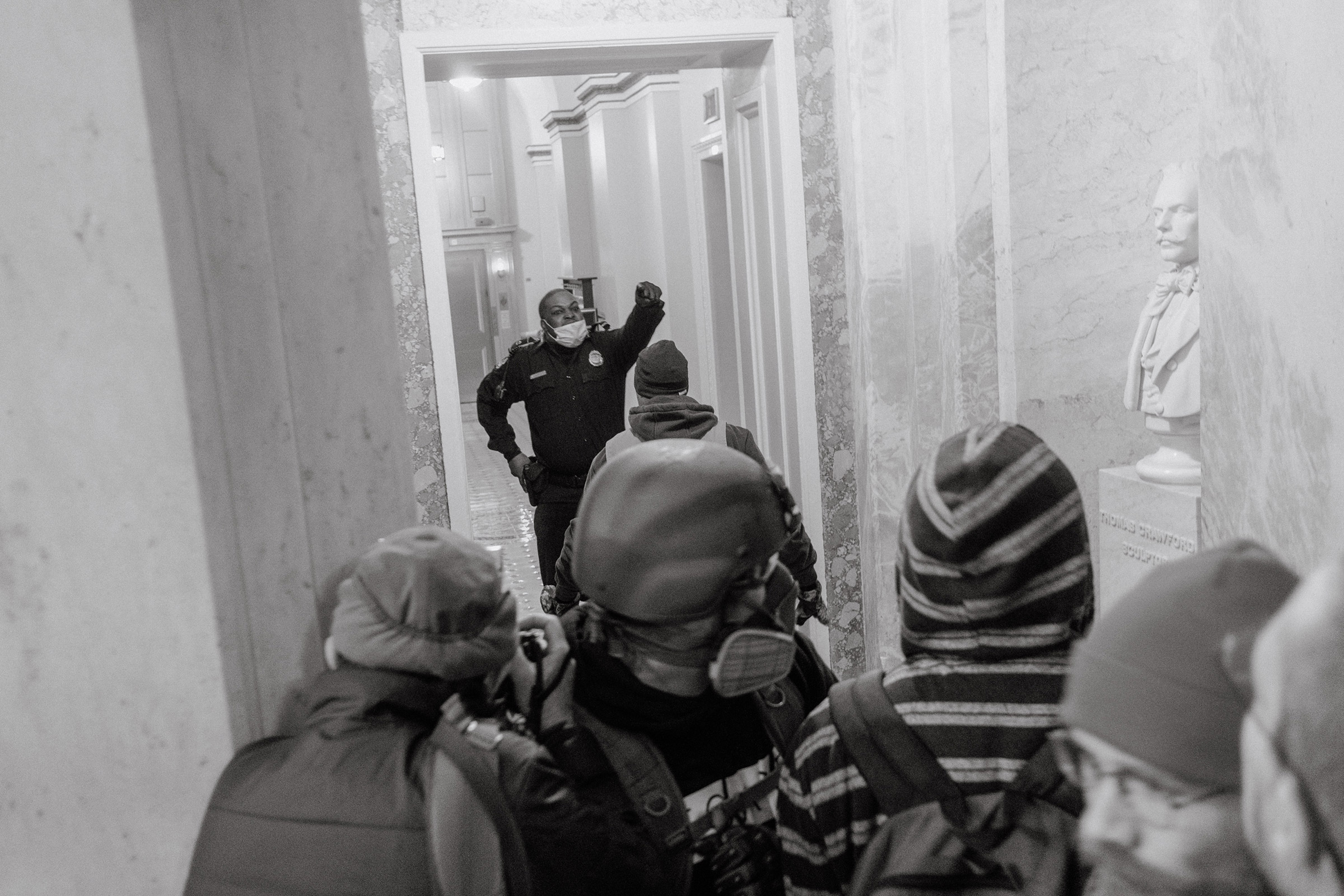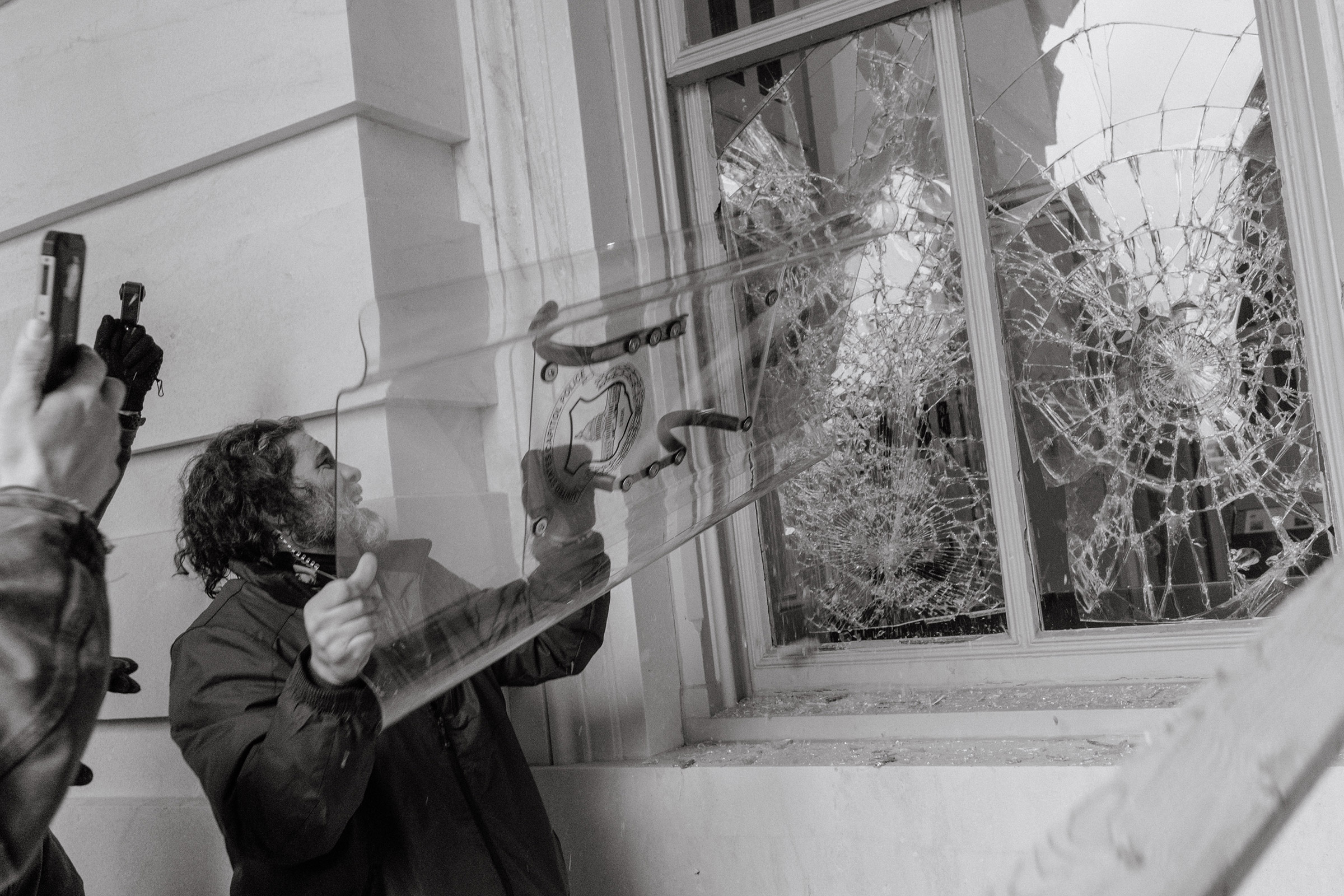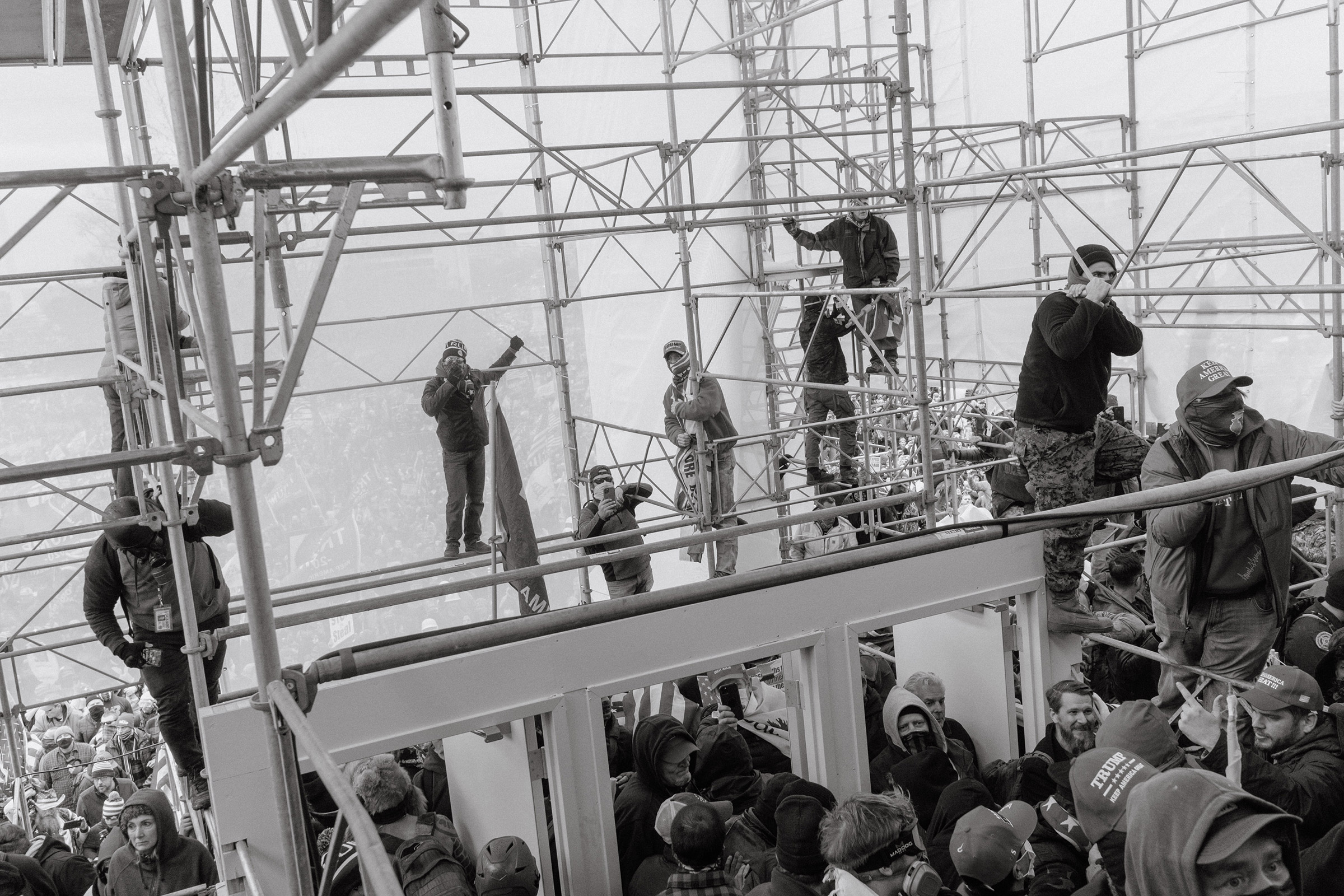
Retired Capitol Police officer Theortis “Butch” Jones remembers the second Million Man March on Washington well. It was the year 2000. Sent out at 3:30 a.m, the earliest the now-69-year-old former cop had ever been deployed on the streets, he was briefed to expect large crowds and possible violence. “Nobody was out there but us and the rats,” Jones says.
The Black D.C. native can only recall two times the Capitol Police were sent out that early in his 36-year career: for that march, organized by Nation of Islam leader Louis Farrakhan, and for President Barack Obama’s first inauguration. In both instances, he says, the force was out hours before dawn “because of the magnitude of people they expected” and because “the majority of the participation was going to be Black people.” He blames what he saw as the force’s overreaction to two peaceful events on his superior officers’ racism. “Without a doubt,” he says. “I’ve experienced it.”
This week, with white nationalists, right-wing extremist and self-styled militia groups promising violence in Washington on Wednesday, Jones was shocked that he didn’t see multiple cordons of Capitol Police officers protecting the Capitol Building, as was common practice during his years of service. “If that had been Black Lives Matter,” Jones says, “they wouldn’t have gotten even to the steps of the Capitol.”
Both peaceful protest and civil unrest have lapped at the Capitol steps repeatedly over the decades, including three separate bombs set by various militant agitators. But not since British troops nearly burned the building to the ground in 1814 has it been so comprehensively violated as on Wednesday, when President Donald Trump exhorted an angry mob to march from the White House Ellipse down Constitution Ave. to the seat of U.S. legislative power. “We will never concede,” Trump told the tens of thousands of cheering supporters at his “Save America Rally,” adding “If you don’t fight like hell, you’re not going to have a country anymore.”

The security forces that should have held them back failed spectacularly. The lapse that allowed the insurrectionists to rampage through multiple floors of the sprawling Capitol building for roughly four hours was due in part to the overlapping layers of responsibilities for securing the nation’s capital: the U.S. Capitol Police, which Jones once served; the D.C. National Guard, which could only be deployed by the Secretary of the Army, not the mayor because D.C. is not a state; and the Metropolitan Police Department (MPD), which cannot enter the federal grounds of Capitol Hill unless the Capitol Police requests it, which it didn’t until the rioters were inside.
It was the 2,300-strong Capitol Hill police, charged with keeping 535 U.S. lawmakers, their staff and the buildings on the 16-acre campus safe, that was the last line of defense on Wednesday. The force has come under intense scrutiny in the last two days for its failure to take seriously explicit threats of violence from extremist groups, despite a record of violent unrest and property damage by groups like the Proud Boys in previous weeks’ rioting in D.C. The Proud Boys’ founder Henry “Enrique” Tarrio was arrested by D.C. police, carrying two high-capacity firearm magazines, the day before Trump’s inflammatory speech. It has also been criticized for some of its members’ light touch with the largely white crowd who participated in the attack on the Capitol, particularly in comparison to violence many non-white protesters faced this summer during the racial justice demonstrations.

The blowback has been swift. Senior lawmakers called for investigations into the failed response, and demanded those responsible be fired. Capitol Police Chief Steven Sund resigned Thursday after the officers’ union chief Gus Papathanasiou called for his dismissal. By that day’s end, the House and Senate Sergeants-at-Arms had agreed to leave too. Papathanasiou said the rank-and-file officers had done their duty, prioritizing “lives over property, leading people to safety”; no lawmaker was injured in the melee. Their police union said officers were “sickened by the tragic and avoidable events.”
In the end, it was a violent coda to the tenure of a President who has repeatedly flirted with white extremist groups. Four Trump supporters and Capitol Police Officer Brian D. Sicknick are dead, the officer succumbing to injuries from fighting off the mob, the agency said. One woman was fatally shot by police as rioters were moving closer to lawmakers in the House Chamber, authorities said. Officials have not released details about the deaths of the other three individuals who died, except that they all experienced medical emergencies on Capitol grounds, after the mile-and-a-half hike from the White House’s Ellipse. The district’s Office of the Chief Medical Examiner did not immediately respond to requests for comment. The family of one of the deceased said in a statement that Kevin Greeson, 55, of Athens, Ga., died of a heart attack.

“It felt like a personal failure”
In 2020, millions of people marched in protest after the death of George Floyd, in what political scientists call the largest sustained mobilization in modern history. More than 11,000 people were arrested at demonstrations against racism and police violence from May to July, according to the latest tally by the Crowd Counting Consortium, which collects data from news reports. An Associated Press tally found more than 10,000 protesters were arrested in just the first 10 days after Floyd’s Minneapolis death.
Nationwide, dozens of Black Lives Matter protesters were beaten with batons, hit by cars, doused in pepper spray and wounded by rubber bullets, beanbag rounds and other police weapons. Human Rights Watch said the New York Police Department’s crackdown on a Black Lives Matter march last June in Mott Haven, a predominantly Black and Latino neighborhood in the Bronx, was among the most aggressive police responses.
Civil rights organizations have criticized the difference in law enforcement’s response to those protests and the violent mob on Jan. 6. About 80 people involved in the Capitol breach have been arrested so far, according to the most recent data released by the MPD and the Capitol Police. Most of the arrests were for violating the 6 p.m. curfew, the city’s police chief Robert Contee III said. In the aftermath of the Capitol assault, a video emerged showing an officer gently escorting a woman down the building’s stairs by holding her hand.
More rioters should have been arrested on the spot, says former Washington D.C. Police Chief Charles Ramsey. But police experts say the agency’s failure to plan, which resulted in severely limited resources, made that impossible. “When you’re in that kind of situation, making an arrest is difficult because then that requires you, the officer, to take that person into custody, and that takes you away from the scene,” says Chuck Wexler, executive director of the Police Executive Research Forum, a Washington-based think tank.

Former Capitol Police Chief Terry Gainer says the agency underestimated the size of the crowd and the extent of their anger, believing the protesters wouldn’t try to overtake law enforcement. On Thursday, Acting U.S. Attorney Michael Sherwin said authorities had anticipated the arrival of thousands of demonstrators for weeks but did not expect the breach, which led to a “large amount” of stolen electronic devices and documents from senators’ offices in what could prove to be a national security threat. D.C. police later reported finding at least two pipe bombs, a box of flammable Molotov cocktails and assorted other tools that could be used as weapons, all near the Capitol Building. When asked how police could not have foreseen the assault, Sherwin said “that’s the $100-million question.”
At least part of the answer, Ramsey suggests, lies in the demographics of the crowd. “There’s a bias that exists that you just can’t ignore,” he says. Members of the Capitol mob, he says, “claim to be conservative. They’re mostly white. They claim they love police. I think as a result of that, some people let their guard down. They didn’t think they would attack and do the things they did.” If the crowd was made of mostly people of color, he says law enforcement would have planned and reacted far differently. “I don’t see how you can draw any other conclusion.”
Sherwin pointed out on Thursday that prosecutors had charged 55 Capitol-related cases in the previous 36 hours, mostly for unlawful entry, compared to the 174 total charges they filed within 36 weeks from the BLM protests. “I’m just trying to give you a comparison to show how aggressive and seriously we’re taking what happened yesterday,” Sherwin said. “I don’t want that to get lost on anyone.” The Justice Department on Friday announced it had charged 13 people with federal crimes, including making interstate threats to House Speaker Nancy Pelosi and carrying weapons on Capitol grounds.
Gainer, who headed the Capitol Police from 2002 to 2006 and also served as Senate Sergeant-at-Arms, says officers seem to personally favor Trump politically, but that he does not believe the Capitol Police force as an organization is “inherently biased.” He says he’s still scratching his head at how the “significant, monumental failure” could have happened, even partially blaming himself despite retiring in 2006. “Most of the people involved with this were someone I was responsible for hiring. I was responsible for promoting,” he says. “I was one of the ones responsible for policies and procedures and operations. It felt like a personal failure.”
A “perplexing” response
The city of Washington, D.C., has sweeping responsibility but a patchwork of authorities. The D.C. police chief Contee says his forces could only have acted to stop the marchers if they’d behaved violently, which only happened once they had marched up the Capitol steps, where his people can only enter with at the invitation of the Capitol Police.
The Capitol Police force was established in 1828, according to Samuel Holliday, of the U.S. Capitol Historical Society, a few years after the building was torched by the British, replacing a lone watchman who’d failed to keep the site secure. The force evolved as the compound expanded and it gained independent status from the city in 1979, thanks to an act of Congress.
The force has seen both violence and tragedy. In 1998, a lone gunman stormed the Capitol Building and killed two members of the force, Officer Jacob Chestnut and Detective John Gibson, before being apprehended. The force has fended off other violent attacks over the years, including four Puerto Rican nationalists shooting wildly around the House gallery in 1954, injuring five Congressmen. Three different explosive devices have been triggered overnight or in unoccupied areas of the complex, apparently aimed at grabbing attention rather than harming anyone. The attacks of 9/11 meant the force grew again, Holliday says, especially given the fears that the third hijacked plane, Flight 93, had been headed for the Capitol.
While the force was created to handle “routine building security,” Holliday says it has also developed “professional and respectful strategies to manage large crowds exercising their First Amendment rights in and around campus.” He called Wednesday’s failure to halt the mob a “perplexing response” and an “exception to the rule.”
But the Capitol Police force has faced multiple lawsuits over the years, and has been plagued with allegations of racism by organizations including the U.S. Capitol Black Police Association, which force veteran Jones helped found. “There’s been long-standing concerns around race bias in hiring and promotion practices in the police department,” says Jonathan Smith, executive director of the Washington Lawyers’ Committee for Civil Rights and Urban Affairs.
The independence granted to the Capitol Police by Congress also means less accountability to the public, says Vida Johnson, a Georgetown Law associate professor who has tracked the rise of white nationalist and supremacist sentiment in police forces around the country. As a part of Congress, and therefore not subject to the Freedom of Information Act, “the Capitol Police is super opaque,” she says. “They don’t share any demographic information …. So we actually don’t know the racial makeup of their force.”

The lack of preparation for the Wednesday march was another example of the force’s implicit bias towards whites versus people of color, says Smith, given the fact that much of downtown D.C. was boarded up days beforehand, and the mayor warned people to stay off the streets. “It’s a particularly disturbing contrast to what we’ve seen happening when Black demonstrators and their allies have been out against police misconduct and seeing the federal response,” says Smith, whose group is suing Trump for the use of tear gas and rubber bullets to clear protestors from Lafayette Park last June.
Black Lives Matter DC organizer Neenee Taylor says that pattern of discrimination is also directed at those who enter Capitol grounds. She says one of her volunteers, a 23-year-old Black college student, was arrested and held overnight for filming a peaceful protest against the nomination of Amy Coney Barrett last fall. “No one else was arrested but her and one other white lady, and the white lady was let go.” All charges against the student were later dropped, Taylor says. “We’re criminalized … because of the color of our skin.”
The U.S. Capitol Police did not immediately respond to repeated requests for comment.
On Friday, a bipartisan group of U.S. Senators announced their intention to investigate the failure of security on Wednesday at the Capitol. But Dr. Michael K. Fauntroy, who teaches political science at Howard University, says it will take action against those Capitol Police officers who were seen helping or hobnobbing with the rioters — instead of stopping them — to win back the trust of the Black community. “Not just firing, but prosecution,” he says. Then again, Fauntroy says there wasn’t much trust to begin with. “I don’t know of any Black person who would be surprised at seeing what they saw, the double standard with which Black people in America live.”
More Must-Reads from TIME
- Cybersecurity Experts Are Sounding the Alarm on DOGE
- Meet the 2025 Women of the Year
- The Harsh Truth About Disability Inclusion
- Why Do More Young Adults Have Cancer?
- Colman Domingo Leads With Radical Love
- How to Get Better at Doing Things Alone
- Michelle Zauner Stares Down the Darkness
Contact us at letters@time.com